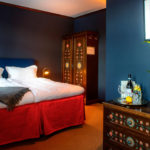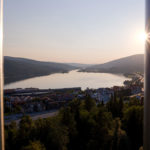A historical journey through and around Åre
Åre is growing and expanding. Today, it’s a modern ski resort with new championships, new buildings, new lifts and new businesses. It all started as a scattered farming village along the ancient passage route from Sundsvall to Trondheim. Let’s take a turn through the landmarks of time.
We begin at Åre Hembygdsgård in Ullån at the western end of the village with a view overlooking Mt. Åreskutan. The farm itself may not be so historic as mostly everything on site was moved there to show what an Åre parish farm looked like in the 19th century. However, it is an old rescued house which happens to be a wonderfully cosy and quiet place to visit. On site is an old manor house, two hay granaries, a barn with a baking oven, a confectionery shop, a school shed and an old forge. The manor house has furnished rooms with historic objects from the village that tells a history of the alpine farm culture, and it’s here the farm’s café is open during the summer. You may even get lucky and can try baking the traditional Swedish thin bread or buy freshly baked thin bread in the café.
The journey continues to the centre of Åre and the old church, Åre gamla kyrka – the only medieval stone church in Scandinavia’s mountain world! Keep in mind that it has been in place since the late 1100s. Then, it was half as big as today, but it was enough for the Åre parish until the 18th century when it was expanded to the present size and the updated interior it has today. The 18th century also modernised the sacred image of the Viking King St. Olav (dating back to the 13th century) by replacing the King’s crown with a Karoliner hat. The church was also a popular visit for those on the Pilgrim’s Trail (St. Olavsleden) which runs from Selånger to Trondheim via Åre.
Next stop on the tour is the Åre Museum located in the upper station of the funicular Åre Bergbana next to Hotell Fjällgården. Åre Museum was inaugurated in 2013 in this historical building from 1910 and showcases how Åre evolved from a farming village to an internationally known tourism destination. You will find objects and pictures telling stories about the Sámi people, the peasant community, the many health care guests coming for rehabilitating in the clean air, the significance of curling and bobsleigh for the development of Åre and much more.
Our journey ends in Fröå Gruva, a mile from the centre of Åre. Mt. Åreskutan’s eastern side extends far away, and it’s from here that you can see how impressive the mountain is. Our reason for visiting Fröå Gruva is not just the view, but the well-preserved copper mine that was in operation from 1744 to 1919. During this time a mining community grew forth and many of the houses remain the same today. For an easy way to dive into 19th century life in this small village is simply to take a walk along Torprundan (point 224). There are information signs on most of the houses that describing the buildings and the area’s history. During the summer and winter season, Bergstugan is open for lunch, sweet treats and coffee.
Last updated 4 August 2023











